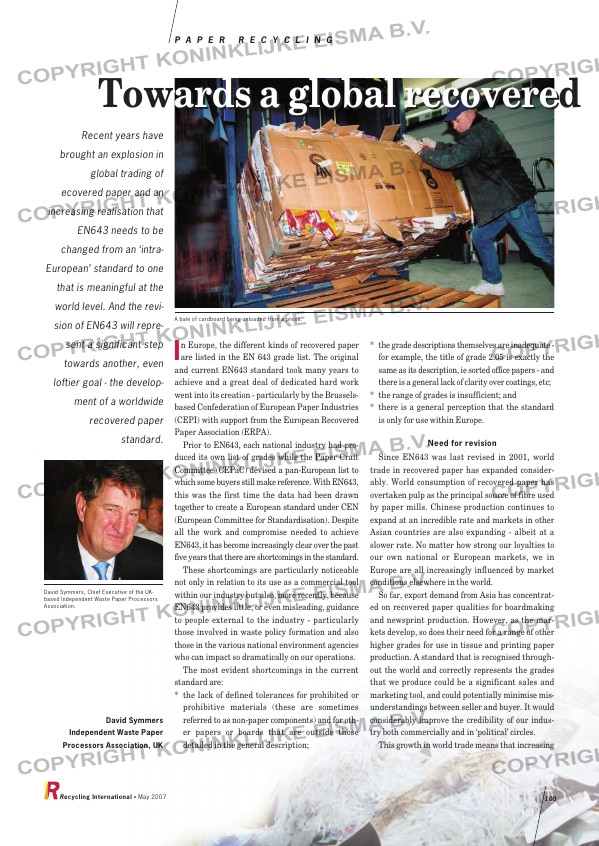Page 100 from: May 2007

In Europe, the different kinds of recovered paperare listed in the EN 643 grade list. The original
and current EN643 standard took many years to
achieve and a great deal of dedicated hard work
went into its creation – particularly by the Brussels-
based Confederation of European Paper Industries
(CEPI) with support from the European Recovered
Paper Association (ERPA).
Prior to EN643, each national industry had pro-
duced its own list of grades while the Paper Craft
Committee (CEPaC) devised a pan-European list to
which some buyers still make reference. With EN643,
this was the first time the data had been drawn
together to create a European standard under CEN
(European Committee for Standardisation). Despite
all the work and compromise needed to achieve
EN643, it has become increasingly clear over the past
five years that there are shortcomings in the standard.
These shortcomings are particularly noticeable
not only in relation to its use as a commercial tool
within our industry but also, more recently, because
EN643 provides little, or even misleading, guidance
to people external to the industry – particularly
those involved in waste policy formation and also
those in the various national environment agencies
who can impact so dramatically on our operations.
The most evident shortcomings in the current
standard are:
* the lack of defined tolerances for prohibited or
prohibitive materials (these are sometimes
referred to as non-paper components) and for oth-
er papers or boards that are outside those
detailed in the general description;
* the grade descriptions themselves are inadequate –
for example, the title of grade 2.05 is exactly the
same as its description, ie sorted office papers – and
there is a general lack of clarity over coatings, etc;
* the range of grades is insufficient; and
* there is a general perception that the standard
is only for use within Europe.
Need for revision
Since EN643 was last revised in 2001, world
trade in recovered paper has expanded consider-
ably. World consumption of recovered paper has
overtaken pulp as the principal source of fibre used
by paper mills. Chinese production continues to
expand at an incredible rate and markets in other
Asian countries are also expanding – albeit at a
slower rate. No matter how strong our loyalties to
our own national or European markets, we in
Europe are all increasingly influenced by market
conditions elsewhere in the world.
So far, export demand from Asia has concentrat-
ed on recovered paper qualities for boardmaking
and newsprint production. However, as the mar-
kets develop, so does their need for a range of other
higher grades for use in tissue and printing paper
production. A standard that is recognised through-
out the world and correctly represents the grades
that we produce could be a significant sales and
marketing tool, and could potentially minimise mis-
understandings between seller and buyer. It would
considerably improve the credibility of our indus-
try both commercially and in ‘political’ circles.
This growth in world trade means that increasing
P A P E R R E C Y C L I N G
Recycling International • May 2007 100
Recent years have
brought an explosion in
global trading of
ecovered paper and an
increasing realisation that
EN643 needs to be
changed from an ‘intra-
European’ standard to one
that is meaningful at the
world level. And the revi-
sion of EN643 will repre-
sent a significant step
towards another, even
loftier goal – the develop-
ment of a worldwide
recovered paper
standard.
David Symmers
Independent Waste Paper
Processors Association, UK
Towards a global recovered p
A bale of cardboard being unloaded from a press.
David Symmers, Chief Executive of the UK-
based Independent Waste Paper Processors
Association.
RI_018 EU Paper Grade List:Opmaak 1 02-05-2007 11:54 Pagina 100



